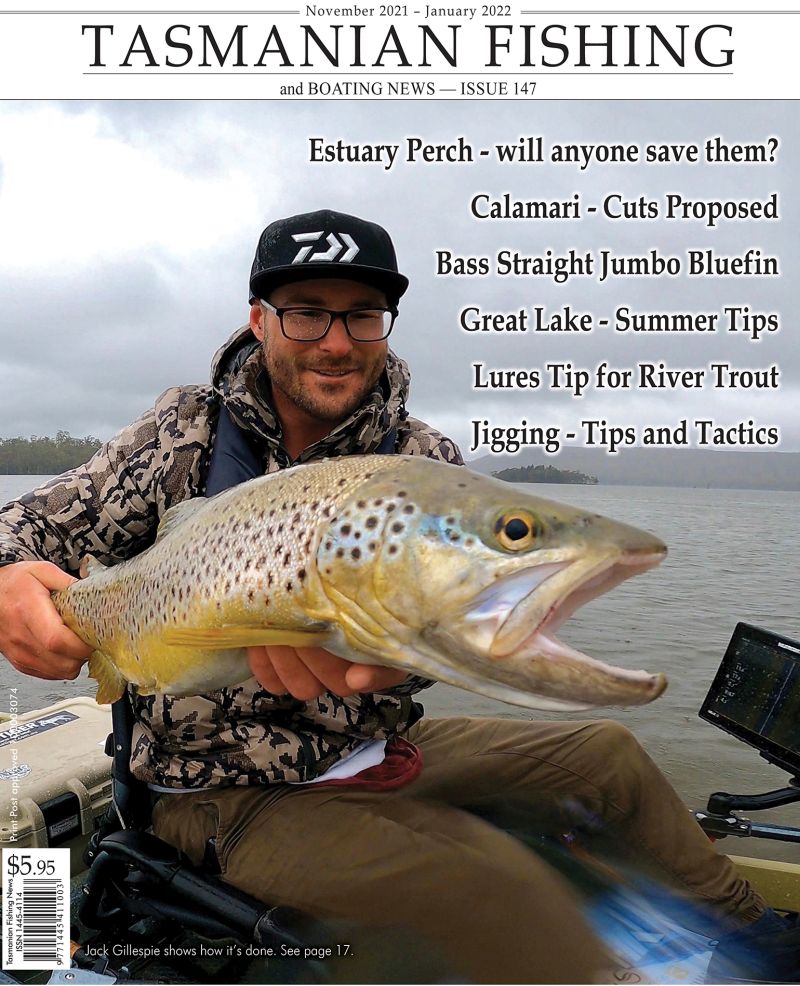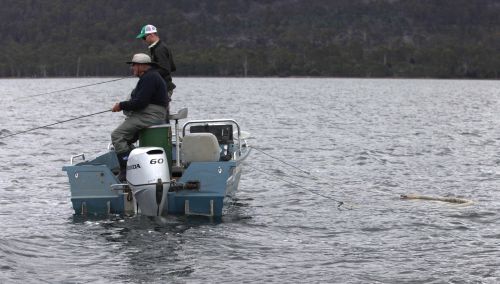From the Archives ...
Sea Trout Fishing - October and November
Sea Trout Fishing - October and November
Christopher Bassano
Fishing guide Christopher Bassano explores his favourite fishing-and shares a few tips that will help you discover the world of trout near the sea.
Please check all relevant authorities before fishing - www.ifs.tas.gov.au and dpipwe.tas.gov.au . Don't forget issuu.com/stevenspublishing for years of back issues !
D'Entrecasteaux Channel
Getting there; South of Hobart.
Major angling species; Flathead, cod, morwong (perch) Australian salmon, Atlantic salmon, trout, barracouta, bream, mullet, squid, pike.
Special restrictions; Recreational fishing only.
Other attractions; The D'Entrecasteaux Channel is a large area and has many attractions. It is a popular area for boats, yachting, bushwalking, vineyards and historic monuments plus there is the Woodbridge Marine Centre, Hastings Caves, thermal pools and some beautiful picnic areas.
The D'Entrecasteaux Channel consists of an area between Bruny Island and Tasmania's mainland. The main channel itself is a haven for a range of bottom dwelling fish, such as flathead, perch, cod, and the occasional gummy shark. As a "recreational only"fishery it receive little fishing pressure and reliable catches can almost be assured all year round.
A number of pelagics visit the Channel during the year. These include Australian salmon, barracouta, mackerel, warehou and squid.
Atlantic Salmon - Sea cage cultivation of Atlantic salmon occurs along the south-east coast and escapees are often taken by recreational anglers. Break-outs are common, being the result of damage by seals, storms and human error. The fish commonly weigh 3-4 kg. Atlantic Salmon are superb eating and fight well.
The hot spots are in the open water adjacent to the sea pens in the D'Entrecasteaux Channel and in sheltered areas such as Port Esperance (where there is scope for fishing from the bank). The best results come in the first fortnight or so after a major escape. Often the fish can be seen breaking the water and sometimes they can be polaroided.
Some Professional guides run charters in this area chasing Atlantic salmon.
Access to the Channel is good with many areas accessible from the shore. Plenty of small boat ramps are scattered along its length.
D'Entrecasteaux Hot Spots
Dover-Port Esperance
Port Esperance is probably the best location in the Channel - primarily due to its diversity. The angler can either go out in the bay or fish around the islands for fast action on flathead, salmon and barracouta. The real feature of the area is the Esperance River though which contains Atlantic salmon, sea-run trout and bream.
Atlantic Salmon congregate in schools when they escape from the farms. Further up-river bream and sea-run trout reign supreme. The whitebait run can get the sea-runners quite excited and they can be seen in the shallows charging at schools of whitebait.
The two best places are the Dover jetty and in front of the Esperance Camp on the river.
Southport
The large jetty at Southport provides a good structure to catch barracouta, squid, flathead, mackerel and leatherjacket. The surrounding rock platforms contain reliable numbers of food sized wrasse.
A popular area is the Lune River. The Lune is similar in many ways to the Esperance River although the Lune produces many more large trout - sometimes up to 7 kg. The Lune is also home to flathead, small Australian salmon and a good population of very hard to catch bream.
Gordon, Woodbridge and Kettering
All these areas are similar and offer huge scope - especially for the land based angler - due to their good structure. Gordon has good squid runs when they enter the Channel and it also supports a good population of the common species.
Woodbridge jetty is similar again and is worth a visit just to see the Woodbridge Marine Centre. Kettering is the location from where the Bruny Island ferry departs and although it is a busy bay it still fishes well.
- Category: Tassie Hot spots
- Hits: 34409
Saltwater fishing Tasmania
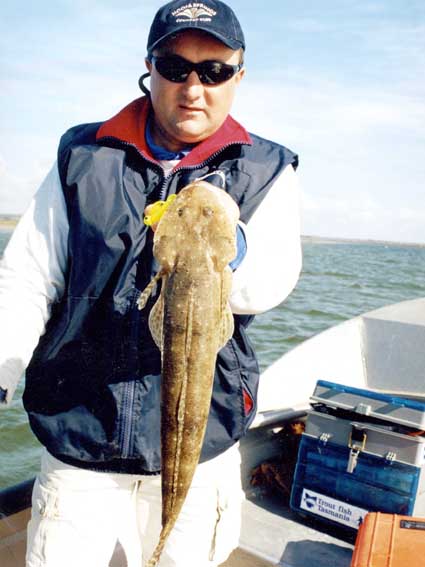
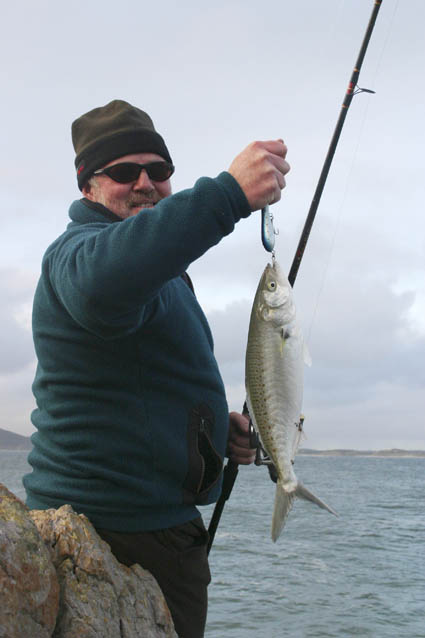
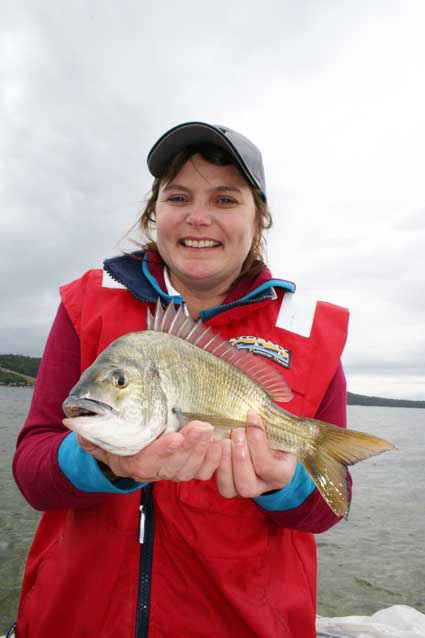

Tasmania holds its head high in regard to quite a few saltwater fisheries. For many years Tasmania has had recreational bag limits for all game fish and in 2001 introduced bag limits for all saltwater species. Whilst some recreational netting is still allowed it is banned in almost all bays, rivers and estuaries - as is commercial netting.
Tasmania holds several world records for southern bluefin tuna including a fish of 108 kilograms on 15 kilogram line. Although good numbers of fish had not been caught for several years, 2001 saw the return of some great gamefishing return off Tasman Peninsula. Whilst St Helens is largely regarded as the game fishing capital of Tasmania, Tasman Peninsula rules the roost for bluefin.
Large yellowfin tuna, striped marlin, albacore, striped tuna and mako sharks are also available on the east coast from Flinders Island to Tasman Peninsula. In recent times professional charter operators have developed this fishery with most operating from St Helens. Striped marlin are perhaps the most sought after prize and in recent years the numbers caught every year are increasing.
The best way for visitors to go game fishing is to hire a charter operator. Their knowledge, boats and equipment are all first class. These are professionals who are on the water almost every day and can maximize your chances. Charter operators operate under a strict code of practice which was initiated by the Sea Charter Boat Owners and Operators of Tasmania.
Southern black bream are another fish eagerly sought in Tasmania. These are mostly an east and northern coast fish that grow to well over three kilograms. Nowhere else in Australia is the average size as big and a genuine four pound fish is well within the reach of keen anglers. Little Swanport and Ansons Bay are hot spots for big bream.
Of course there are many other species eagerly sought, these are just two examples of Tasmania's unique saltwater fishery.
Tackle outlets - whether bigger city shops or small general stores are all very helpful. Ask any angler on a beach or wharf and mostly they will be only too helpful.
You do not need a licence for saltwater fishing in Tasmania's seas with a rod and line. A recreational sea fishing licence is required to fish for abalone, rock lobster and scallops or with a graball, mullet and beach seine net.
See http://dpipwe.tas.gov.au/sea-fishing-aquaculture/recreational-fishing/recreational-sea-fishing-licences
- Category: Fishing Information
- Hits: 119135
Mako Madness
by Scott Baker
It's early February, and with the water temperature starting to rise, and the appearance of the small pelagic tuna off the north east coast. Wade Pelham and myself decided it would be a good time to seek out a highly regarded game fish; the Blue Pointer or more commonly known as the Mako.
- Category: Saltwater and Estuary Fishing
- Hits: 9269
Hart's Hints - Little things can make a difference
by Andrew Hart
Fish can often be very frustrating. Many people find themselves going fishing for an afternoon of relaxation, and end up getting all uptight because of some little, annoying thing that could have been avoided.
There are many simple, innovative ideas that can make the wonderful world of fishing a whole lot easier. Some of these ideas are available at your local tackle shop, others can be put into practice around the house.
In this, the first article of a series, listed are some useful tips, techniques and accessories that make a huge difference.
- Category: Tackle, Boats and other Equipment
- Hits: 5766
Read more: Harts Hints. Little things can make a difference.
Do we underestimate our Redfin Perch
The Redfin as it is known to most Tasmanians is not favoured by many anglers - although there is no reason why this should be so. The Redfin will take flies, lures and bait readily and is quite good to eat. A lot of anglers consider it a nuisance good ENGLISH PERCH (Redfin-Perca fluviatilis) According to a Royal Commission report on the fisheries of Tasmania issued in 1882-3, the English Perch was first introduced to Tasmania in 1862 by two brothers, Morton and Curzon Allport.
- Category: Other Lakes
- Hits: 16996
Derwent River trout an early treat
Steve Bax from Hobart's Fishing Connection previews fishing for sea run trout in the Derwent River.
Some of the best trout fishing in Tasmania is found on Hobart's doorstep in the Derwent River. At this time of the year most anglers catch their fish on bait - using the local pretty fish, but there is also dedicated band of fly fishers. The pretty fish are found all over the Derwent, as are the trout.
- Category: Derwent River
- Hits: 9037
Cooking Tamar River Cod
by Steve Suitor
Two of the most prevalent species present in the Tamar are Flathead and Cod.
Flathead has a firm white flesh which is excellent fare whether it be fried, grilled,BBQ or soused. While most cooks have little trouble presenting flathead in an attractive and appetising manner, a great many have trouble with cod.
- Category: Cooking Fish
- Hits: 10422
Lures and flies for August and September
by Michael Stevens
Recently I surveyed a number of well known, and some not so well known anglers to establish a guide to lures and flies for the start of the trout fishing season. Firstly lures, and then flies that the following anglers would like to have in their box for the opening two months. Each angler was asked "If you could only have three lures/three flies in your box for the start of the season, what would they be? "
- Category: Tackle, Boats and other Equipment
- Hits: 12914
Redmap Newsletter Signup

Join up to Redmap between now and 31 March 2011 and you’ll go in the draw to win a $400 voucher to spend on fishing gear, dive and snorkelling equipment OR marine gear. Visit http://www.redmap.org.au/news/posts/view/65/win-a-400-voucher/ for more details.
- Category: IFS, DPIPWE, MAST and Peak Bodies
- Hits: 5706
Subcategories
Current TFBN
Click above for current issue content. The current issue of TFBN is extensive and topical. In Tackle Stores, Newsagents and by subscription.
Delivered to your door for $48 for 2 years (8 issues). To subscribe, send Mike $48 via www.paypal.com.au . (Basic instructions are here) The email is at Contact Us. Your address will be included from PayPal.
Or phone Mike with your c/c handy on 0418129949
Please ensure your details are correct, for Mike to organise delivery.
TFBN Newsletter Sign up Form
Why not submit an article ?
When you have finished for the day, why not have a brag about the ones that didn't get away! Send Mike an article on your fishing (Click here for contact details), and we'll get it published here. Have fun fishing - tasfish.com
Category Descriptions
Here is a list of all of the Article Categories. The number in Brackets, eg (13) is the number of articles. Click on Derwent River and all articles relating to the Derwent will be displayed in the central area.
Articles by Category
-
Rivers (3)
-
Saltwater and Estuary Fishing (149)
-
Kayak Fishing (34)
-
Lakes (1)
-
Great Lake (62)
-
Lake Leake (52)
-
Woods Lake (16)
-
Lake Augusta (11)
-
Huntsman Lake (13)
-
Lake Pedder and Gordon (10)
-
Lake Dulverton (5)
-
Lake Crescent (6)
-
Tooms Lake (10)
-
Lake Mackintosh (2)
-
Lake Barrington (5)
-
Little Lake (8)
-
Meadowbank Lake (5)
-
Lake King William (7)
-
Lake St Clair (2)
-
Western Lakes (12)
-
Arthurs Lake (35)
-
Lake Echo (7)
-
Four Springs (54)
-
Lake Sorell (7)
-
Lake Burbury (6)
-
Other Lakes (57)
-
Brushy Lagoon (18)
-
Little Pine Lagoon (5)
-
Penstock Lagoon (16)
-
Brumbys Creek (7)
-
-
Events (48)
-
Estuary Fishing (0)
-
Coastal Catches (46)
-
Super Trawler (46)
-
IFS, DPIPWE, MAST and Peak Bodies (435)
-
Commercial Interests (98)
-
Other (24)
-
TFBN Back Issues (8)
-
Fly Fishing (67)
-
Trout Fishing (252)
-
Meteorology and Weather (8)
-
Jan’s Flies (50)
-
Tuna Fishing and other Game Fishing (86)
-
Cooking Fish (19)
-
Fishing Information (1)
-
Fishing Books (8)
-
Videos (5)
-
Tackle, Boats and other Equipment (146)
-
World Fly Fishing Championship 2019 (2)
Popular Tags
windyty.com
Visit https://www.windyty.com/
Rubicon Web and Technology Training
Hello everyone, I thought it would be a good time to introduce myself.
My name is Stephen Smith and I have been managing the website tasfish.com since May 2009.
It has been an epic journey of learning and discovery and I am indebted to Mike Stevens for his help, support and patience.
I am developing a new venture Rubicon Web and Technology Training ( www.rwtt.com.au ). The focus is two part, to develop websites for individuals and small business and to train people to effectively use technology in their everyday lives.
Please contact me via www.rwtt.com.au/contact-me/ for further information - Stephen Smith.
From the Archives ... (last chance)
Atlantic salmon the hard way
Atlantic salmon the hard way
Scott McDonald
The first Atlantic salmon eggs used to begin Tasmania's Atlantic salmon aquaculture industry were introduced into Tasmania in 1984. From these humble beginnings a valuable Tasmanian industry has evolved with a worldwide reputation for having a premium disease free product. This industry provides a spin off to all anglers in the form of regular escapes of salmon from the farms.

